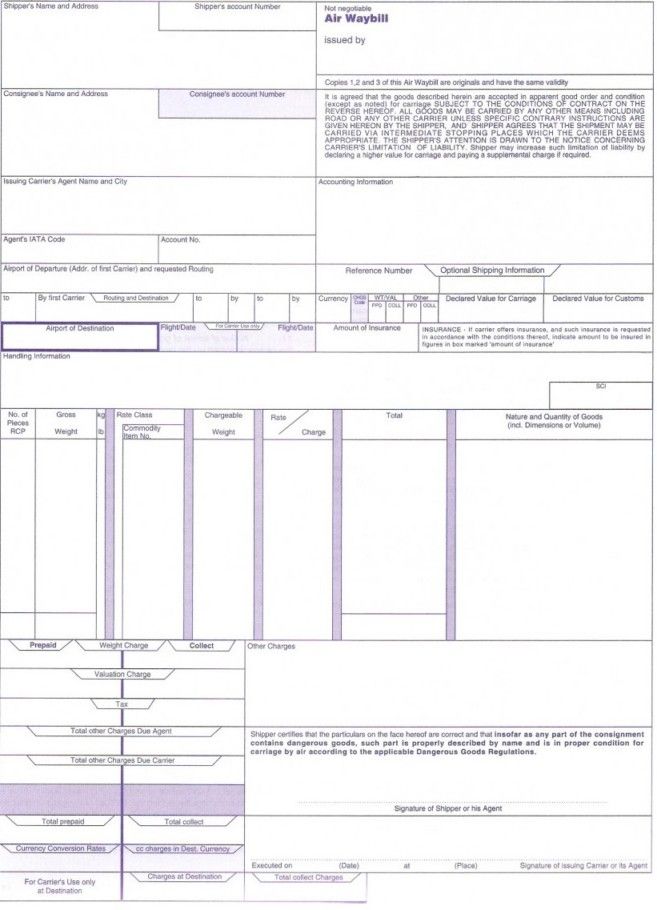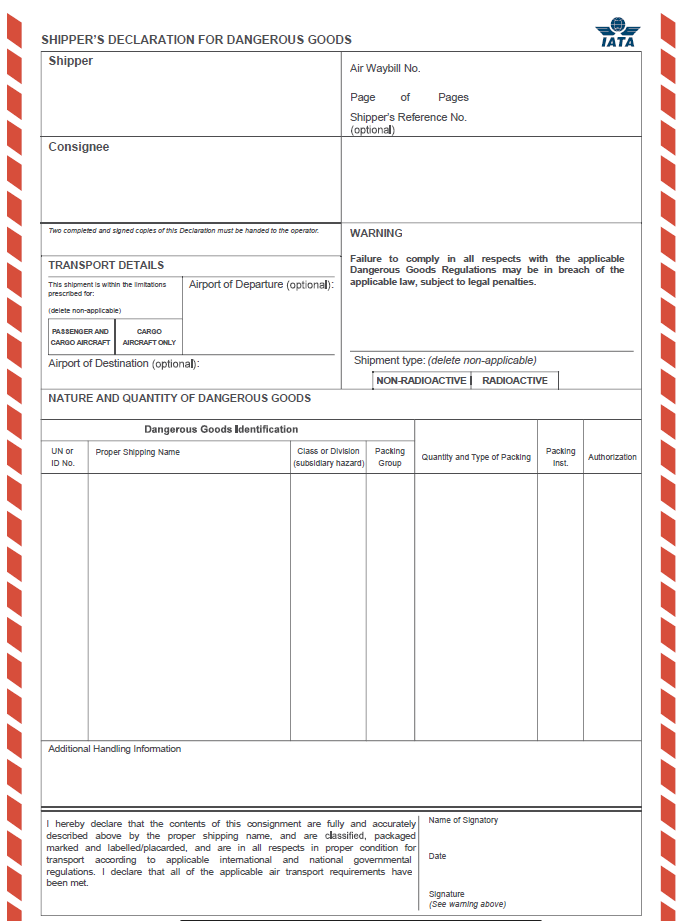Air Transport Documentation
The overall requirements for and types of documentation used for air transport depend on the nature of the air transport. The normal documentation requirements for most shipments (waybill, packing list, proforma, etc) applies to all shipments, including air shipments. There are documents specific to air shipping however. These might include:
Airway Bills (AWB) - By far the most common and important document related to airfreight. AWBs are regulated by IATA, and have a standard format for ease of reading and reference. It should be noted that AWBs are only legally required for international transport, however domestic CAA and even non officially regulated air carriers can and do request the use of AWBs. The AWB is the carrier’s receipt by air, evidence of the contract of carriage and is usually non-negotiable. It is made out to a named consignee who is the only party to whom the carrier can deliver. Many carriers even make it easy to track and trace cargo in real time using AWB numbers on their website. Through its standardised layout, AWBs will denote:
- Shipper name and contact details
- Consignee/Notify party name and contact details
- Special handling information
- Cargo description, including item description and total chargeable weight
- Customs value
The above information should match the information coming on other shipper generated shipping documents. In the top right corner of every official AWB, there will be an AWB number, which is unique to that one AWB. The AWB number is always eleven digits; the first three are the IATA designated airline prefix, while the last seven digits are the unique serial number. Many airlines make AWB numbers easy to trace online.
Original, airline generated AWBs are generally the only acceptable AWBs that customs authorities will recognise. The original paper copy will go with the consignment, but scanned copies are usually acceptable for customs purposes. The AWB generated by the airline is typically referred to as the “Master” AWB, or sometimes MAWB.

House AWB – A “House” AWB – sometimes referred to as a HAWB - is generated by a forwarder or broker and provided to a client upon request. HAWBs generally have all the same information as a regular AWB, but are not necessarily signed or have the same tracking information as the MAWB. Customs authorities generally do not recognise HAWBs as an official document for customs procedures as there may be some difference between the HAWB and the MAWB. HAWB may still be useful for internal tracking purposes, however.
Non-Standard Waybills – In emergency settings, especially when in-country movement is required via air, the AWB may not be applicable or available. Cargo moved via unconventional air movement will generally always require some form of documentation, however this may look like a stand-alone packing list, self-made cargo manifest (similar to a packing list), or in the case of movement on military assets, a standard form internal to that specific military.
Shippers Declaration of Hazardous Goods (HazDec) – Much like AWBs, HazDecs are predefined by IATA, and are essential to the shipping process. HazDecs contain relevant information on any and all DG items for loadmasters and pilots. Any airline following IATA regulations will not accept a completed HazDec unless it was filled out and signed by someone who is fully certified in DG handling through an IATA accredited program. Failure to comply with proper completion of a HazDec, or incidents that may occur from incorrectly documented DG can result in fines, court action and jail time. Please consult the Dangerous Goods section to this guide for more detailed information.

Chargeable Weight
When procuring air transport services, planners must contend with what is called "chargeable weight". As a general rule, airlines charge customers per the gross weight of their cargo. Due to the nature of air travel, an increase in weight generally means an increase in fuel, which is an increase in cost. However, some shipments by their nature are extremely light even though they may take up a large volume. Even though light cargo may take up less fuel, airlines must still charge some basic minimum to recover their operating costs as charting per weight would actually lose them money.
To address income loss to non dense cargo, air operators may speak in terms of "volumetric weight" or "cubic weight." Volumetric weight is a method of determining how to evaluate the relative costs of transporting items based on their volumes. Volumetric weight can be calculated using the following equations:
Metric | |
Imperial | |
Imperial to Metric |
Chargeable weight then refers to the "relative" weight an airline will bill customers at. As a general rule, the transporter will quote customers which ever the greater cost between the two weight values is - the actual gross weight of the cargo or the volumetric weight of the cargo. The airline will be the ultimate party determining how to charge customers, but users of air service should pay close attention to the resulting "chargeable weight" contained on their AWBs. There may be situations where the chargeable weight is significantly higher than their gross weight, which can impact budget and planning.

Movement Timing
In the world of aviation, timing is an enormous factor. Aircraft operating out of commercial airports must adhere to strict schedules and time tables.
- Regularly scheduled air craft typically have pre-defined routing that means they will land and take off at specific intervals that will not change much.
- Charter aircraft are frequently being bid upon by multiple parties, and unless a contract is signed they cannot commit for long periods of time.
- All aircraft are subject to the time tables of the airport they operate in. Large commercial airports might limit the amount of time aircraft can spend on the ground before accruing additional charges. Aircraft will typically only be allotted a limited time in specific parking spots as well.
When arranging to ship cargo by air, parties should be prepared well in advance and have all cargo ready at exactly the time specified by the forwarder or the air operator. A failure to deliver cargo on time could result in additional charges, or losing space on the aircraft all together.
Local Aircraft Contracting
In austere operating environments, individual response agencies may require the use of ad-hoc cargo movement using local air operators. Identifying and understanding the proper aircraft or proper service provider can be extremely challenging, especially at local levels operating with limited time and budgets.
Locally operated aircraft in emergency or conflict settings pose unique and enhanced risks to parties who may wish to contract the service:
- Local/small aircraft may not be fully registered to operate in the context of operation.
- Local operators may have insufficient safety standards, or a known history of safety and security incidents humanitarian agencies may not know.
- In conflict settings, local air operators may be involved with transportation of weapons or supplies to parties of the conflict, sometimes along the same route humanitarian organisations operate.
- In any context, local operators may be involved with smuggling, human rights violations, or other illegal or unethical activities.
As a general rule, humanitarian agencies should not charter local aircraft directly with owners of aircraft. Instead, small scale or local charter aircraft should still be solicited through a reputable and known freight forwarder or brokerage service. Though going through a third-party may add some additional costs, forwarders and brokers have access to information or tools that enable them to screen for inappropriate or unethical transporters. The contracted payment terms and arbitration processes will also likely be more transparent and well defined when going through a reputable third-party.
In the event a third-party forwarder or brokerage is not available or not able to sufficiently fulfil the charter needs, and a humanitarian agency still wishes to solicit local air transport, there are a few steps to be considered by contracting agencies:
- Obtain aircraft registration/tail number, and names of pilot and crew. Though a forwarder may not be able to contract with the party, they may still be able to do a due diligence check.
- Ask other agencies who used the service in the past, as well as consult with local UN offices who may track aircraft (ICAO, UN agencies contracting air assets in country, etc).
- If possible, contact local Civil Aviation Authorities to both check registration and obtain information on safety history.
- Search for the registration/tail number online to see if the aircraft has been flagged for any reason.
- Ensure the air operator understands the route, locations, and cargo (type, dimensions).
- Never sign a contract unless it has been reviewed by both a lawyer locally, and by a designated legal focal point in headquarters.
- Payment terms should indicate payment is only due on successful delivery of cargo – never accept terms that include payment even if aircraft is unable to perform its contracted duties for whatever reason.

